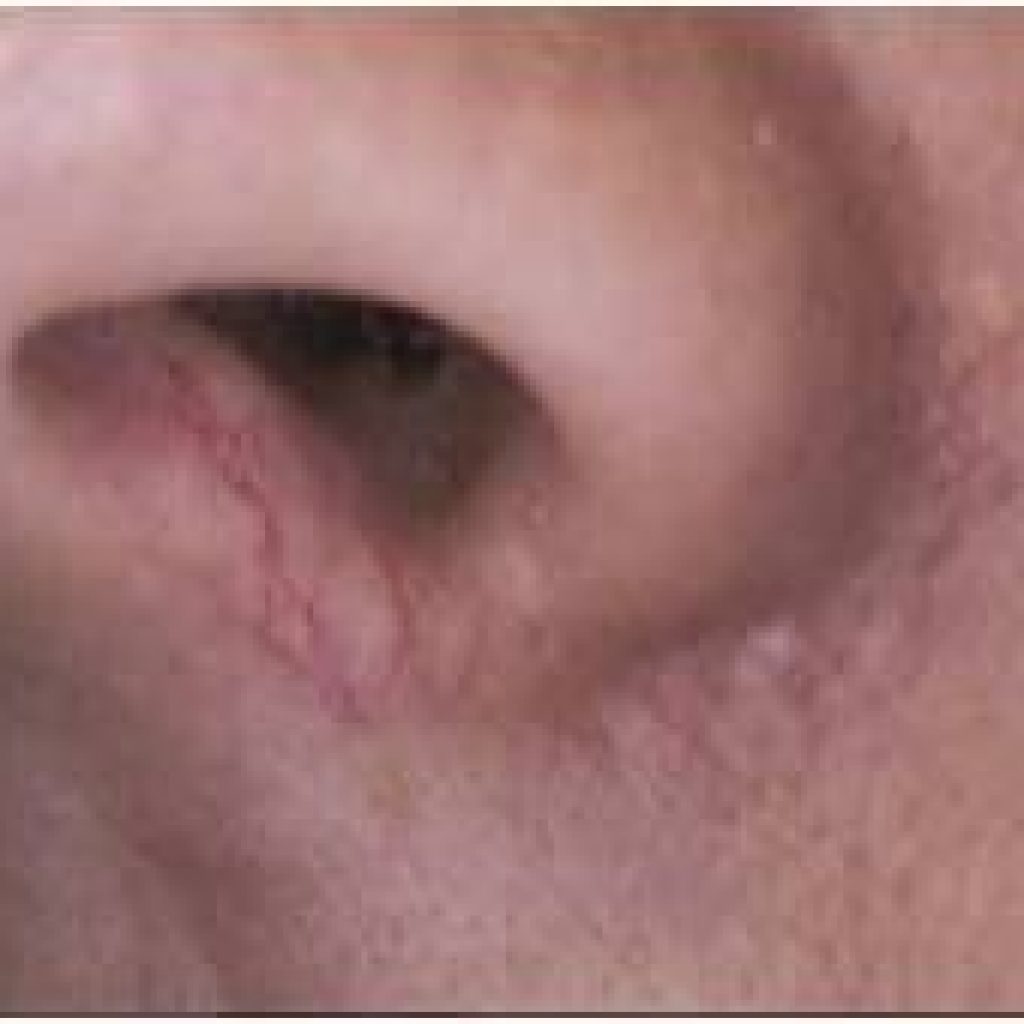In Your Practice
As social media and other societal pressures continue to impact our quest for perfect skin, clients are increasingly turning to you, their skin care provider, for education and professional advice regarding many minor skin imperfections that affect them psychologically.
Dilated capillaries are amongst these Minor Skin Irregularities™ that estheticians are finding they are they are increasingly being asked about by their clients about. Even if only superficial in nature, most dilated capillaries tend to appear most noticeably on the face, which can cause distress to your clients.

What are Dilated Capillaries?
Dilated capillaries (formerly known as “broken capillaries” and medically known as “telangiectasia”) is a term used by skin therapists to describe the superficial blood vessels that lie at the surface, or just under the surface, of the epidermal skin layer. They normally appear as bright or dark red fine capillary lines, but sometimes can be thicker in the nasal area. Dilated capillaries can be straight or or wavy or even circular in shape.
Vasodilation (vaso – blood, dilation – widening) occurs when excessive blood stimulation through the capillaries occurs. When constant vasodilation occurs, the elasticity of the capillaries becomes extended and weakened, so the capillary does not contract back to its original width. The now dilated or widened (or “broken”) capillaries become now more noticeable on the skin’s surface.
Where do Dilated Capillaries appear?
Dilated capillaries tend to appear most often on cheek areas of the face, as well as in and around the nasal area. On thin skins, they are also noticeable on the neck and decollete or upper chest area.
Dilated capillaries tend to occur more on the cheeks and nasal areas as these areas are more susceptible to environmental factors (such as sun, harsh wind etc) that can contribute to the processes of vasodilation.
Due to their red colour, dilated capillaries tend to be more noticeable and prevalent on lighter toned skins, generally Fitzpatrick 1 and 2 skins types. They are also found more often in individuals with thinner skin.

What are the Contributing Causes of Dilated Capillaries?
Experts believe that there is no single cause of dilated capillaries. It is multifactorial and with each contributing factor, the degree of severity of the condition can be amplified. When dilated capillaries appear on the facial area, the environment factors such as the sun and wind are the most common explanation for the vasodilation of the capillaries occurring.
Overall, though, dilated capillaries may be caused by a range of both internal and external factors:
External Factors:
1. Chronic sun and radiation, as well as strong wind exposure, are predominant causes of vasodilation. Therefore, individuals whose occupations or activities requiring them to stay outdoors for a long time are more at risk for developing dilated capillaries. Moreover, the damaging effects of sun exposure may only become evident years afterwards. Individuals who were sun lovers during their youth may develop a predisposition for dilated capillaries later on in life.
2. People who suffer from allergies and/or blow their nostrils often exhibit dilated capillaries around the nasal area. In these cases, the vasodilation of capillaries in the entrance of the nostrils can be quite visible and usually of a wider width than those on the cheeks and elsewhere. Some of these cases can be quite unsightly, especially for men whose capillaries tend to be wider than females.
3. Excessive alcohol consumption or any skin or food irritants, including allergies to cosmetics can cause constant dilation of blood vessels.
4. Pressure exerted on the thighs, especially caused by crossing the legs constantly, can also cause vasodilation of blood capillaries.
Internal Factors
1. Systematic internal factors causing dilated capillaries include high blood pressure, liver disease, drugs and pregnancy.
2. Familial history, such as genetic factors, can make some individuals prone to dilated capillaries.
3. Rosacea or blotchy skins (an indication of constant vasodilation ).
4. Inherited thin skins, especially on the bony areas of the face and body, are more prone to dilated capillaries.
Best Practices on Preventing Dilated Capillaries
When a client asks you if they can take steps to help them prevent dilated capillaries, the answer is yes! But it takes a regular skin care routine and other preventative measures to help maintain moisture and minimize skin damage.
You can advise your clients to always apply a high broad-spectrum sunscreen, a minimum of SPF 30 or even a higher SPF if they are always outdoors. Skin care products such as toners, moisturizers, and serums are beneficial to keep the skin hydrated and protected from irritants that can contribute to the appearance of dilated capillaries. To make it more effective, you can recommend that they keep these products in the fridge for more cooling and soothing effects, as it can also help constrict the vessels.
For clients prone to dilated capillaries, you can recommend that they use tepid water when washing their faces, as cool water closes the pores and aids in the constriction of blood vessels. (Though hot water can soothe a tired body, they should know that hot water, on the face in particular, can contribute to dilation of blood vessels.) On a similar note, during humid temperatures or when staying outdoors for prolonged periods, they can splash the face and neck with cool water regularly to help prevent dilation.
As allergies can also lead to dilated capillaries, clients can be reminded that care should always be taken when using skin care products for the first time, especially if they are herbal in nature. Some product ingredients that can affect dilated capillaries are arnica oil, apple cider vinegar, witch hazel, aloe Vera, vitamin C supplements, sage, calendula, oat, yarrow, marshmallow root, and chamomile.
In terms of lifestyle practices, positive activities such as daily exercise, eating anti-inflammatory nutritious meals, and engaging in other healthy living routines can also minimize the risk or prevalence of dilated capillaries in an individuals..
Traditional Treatments
Dilated capillaries can be treated by some standard clinical procedures, although drawbacks and limitations are involved.
Laser treatments for dilated capillaries are one traditional option, With laser treatments, however, patients normally have to return for a series of sessions until the dilated capillaries are totally removed.
Intense Pulsed Light, another alternative treatment for dilated capillaries, can be an even more tedious choice as the process can require months of treatment, ranging between 3 to 12 sessions.
A further drawback to these treatment options is the inability to precisely treat dilated capillaries without affecting surround skin.
Sclerotherapy, a possible final option, involves the dilated capillaries being injected with a sclerosing agent to help the dilated capillaries disappear. This is a more invasive option, however, that is less suitable for the majority of dilated capillaries which are superficial in nature.
LAMPROBE Treatments – Dilated Capillaries
The LAMPROBE offers skin care practitioners an attractive modern alternative treatment to these traditional clinical methods. The LAMPROBE’s radio frequency and high frequency current coagulates dilated capillaries effortlessly on contact, with unmatched precision.
LAMPROBE practitioners have been using their LAMPROBE for many years to non-invasively treat these dilated capillaries with notable success. Treatment results are instantaneous. As the LAMPROBE practitioner softly taps along the length of dilated capillary, it just disappears as you tap!
LAMPROBE treatments are fast, effective, and non-invasive. Anasthesia is not normally needed, as the sensation is tolerable, and no scarring occurs. A light scab along the treated capillary may appear and disappear on its own within a couple of weeks.
As always, education and training is the path to success. However, it is important to note that only the visible capillaries are treated, not the causes of dilated capillaries. Therefore, home care and preventative care advice are very important.

Conclusion
Dilated capillaries are a common cosmetic superficial skin condition that clients are continuously seek treatment in their search for flawless skin. With the correct background and assessment, today’s skin care specialists can provide the appropriate educational information and professional advice regarding dilated capillaries to calm their clients’ concerns and help them to make informed decisions about managing this common undesirable skin condition.
©Lamskin
Posted in Vascular Minor Skin Irregularities

